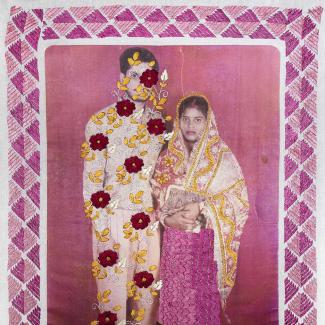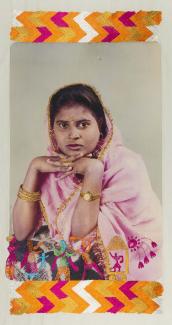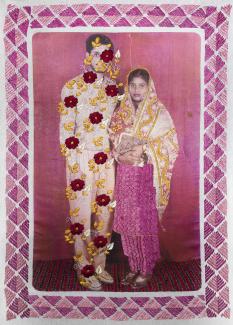
Vadhu: The Embroidered Bride
-
Jump to...
About the Exhibition
Internationally recognized artist, Spandita Malik was selected, in 2022, as THE30: New and Emerging Photographers to Watch. In 2021, Artsy dubbed Malik, one of the 6 rising contemporary artists using traditional craft techniques.
Malik explores the very specific way traditional Indian embroidery has passed down her matrilineal line, becoming a language common to the women in her family. “I learned embroidery from my mother and she learned embroidery from my grandmother,” Malik said. “The oldest embroidery piece embroidered by my grandmother, on maroon silk fabric in gold wire, hangs in my childhood house and is almost 75 years old.
“There has always been a sense of legacy being passed among women through this language of embroidery and handcraft,” Milak continued, “inherited by generations of women and passed along to break the oppressor by simple but significant hand movements captured on fabric, written in thread.”
For her series “Nari,” Malik, who was raised in Chandigarh and now lives in New York, returned to the Indian states of Punjab, Rajasthan, and Uttar Pradesh to investigate famous embroidery techniques indigenous to and still practiced in each place: Chikankari in Lucknow; Zardozi in Jaipur; and Khaddar and Phulkari in Punjab. Malik spent time with women as they crafted, creating a collaborative portrait project, photographing them, and printing the pictures onto local fabrics. Each woman completed her image with her own thread and technique.
A graduate of Parsons School of Design, Malik engages her audience with aesthetic, and then talks about real problems. The approach is part of what Malik calls an “expanded documentary” practice, which addresses social issues via photography and the use of textiles, embroidery and mixed media, which grew out of her undergraduate studies in fashion design. “I am trying to figure out ways to create documentary images, but it's not in the realm of documentary that exists currently,” Malik explains. Her series “Being a Woman,” for instance combines newspaper clippings, embroidery, photographs, drawings and textiles to address violence against women in India.


